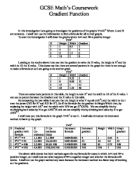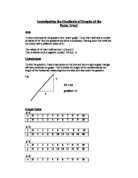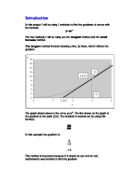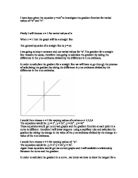GCSE Math’s Coursework
Gradient Function
In this investigation I am going to investigate the gradients of the graphs Y=AXN Where A and N are constants. I shall then use the information to find a formula for all curved graphs.
To start the investigation I will draw the graphs where A=1 and N= a positive integer.
Y=X2
Looking at the results above I can see that the gradient is twice the X value, the height is X2 and the width is 1/2 the X value. This shows me that there are several patterns in the graph but there is not enough to make a formula on so I am going to do another graph
Y=X3
There are some more patterns in this table, the height is now X3 and the width is 1/3 of the X value. I can see no pattern between the Gradient and the X value in this table.
By comparing the two tables I can see that the height is what Y equals (AXN) and the width is the 1 over the power (X/2 for X2 and X/3 for X3). So if the formula for the gradient is Height/Width then, by replacing the height with AXN and the width with X/N we get XN/(X/N). We can simplify this by multiplying both sides by N to get ANXN/X and we can simplify this by dividing both sides by X to get ANXN-1.
I shall now you this formula in the graph Y=X4 to test it. I shall also introduce the increment method to back up my graph.
Y=X4







